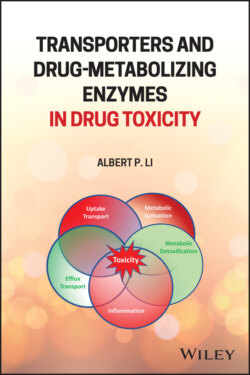Читать книгу Transporters and Drug-Metabolizing Enzymes in Drug Toxicity - Albert P. Li - Страница 51
3.2.1 Drug Metabolism and Toxicity
ОглавлениеAPAP represents a prototypical protoxicant in which metabolic activation is a key mechanism of its hepatotoxicity. Its metabolic activation pathways have been extensively evaluated in both human in vitro systems as well as in vivo in laboratory animals. The generally accepted metabolic activation scheme is that APAP undergoes oxidative metabolism by P450 to N‐acetyl‐p‐benzoquinone imine (NAPQI) which is a highly reactive metabolite that is either detoxified via glutathione (GSH) conjugation or undergoes covalent binding with cellular macromolecules, leading to hepatocellular necrosis. Inflammatory response elicited by cellular injuries and the subsequent Increased oxygen/nitrogen stress mediated by Kupffer cell activation [23] and recruitment of neutrophils [24] may also be involved in APAP hepatotoxicity.
In vitro studies using recombinant human P450 isoforms show that, in comparison to the other human P450 isoforms (CYP1A2, CYP2E1, and CYP2D6), CYP3A4 is the most effective in the metabolism of APAP to NAPQI, with Km equal to plasma drug concentration at therapeutic doses [25]. The association of alcohol consumption with APAP hepatotoxicity has led to the postulation that alcohol enhancement of CYP2E1 activity via increased gene expression [26] and/or enzyme stabilization [27], may be responsible for the increased toxicity [28, 29]. An alternative explanation is that APAP is metabolically activated by CYP3A4 while alcohol consumption depletion of cellular GSH [30–32], leading to compromised detoxification of NAPQI and thereby enhanced toxicity.
